|
|
 |
12
FREIGHT
TRANSPORTATION
Trucking Transportation
Domestic vs International Traffic
Since 1991, the number of tonne-kilometres attributed to for-hire
carriers has increased steadily in both the domestic and international
markets. Domestically, tonne-kilometres rose from 47.7 billion
to 76.7 billion from 1991 to 1998, an average annual increase
of 7.0 per cent. Internationally, tonne-kilometres rose from 22.9
billion to 61.4 billion, an average annual growth of
15.1 per cent over the same period.
In light of these increases, the relative importance of domestic
and international markets in the total traffic of Canadian-based
for-hire trucking firms has been shifting in the past decade.
Since 1991, the domestic share of total tonne-kilometres has decreased
by 15 per cent, resulting in a corresponding increase in
the international share of total tonne-kilometres.
Figure 12-4 shows the growth in annual truck traffic in tonne-kilometres
between 1988 and 1998.
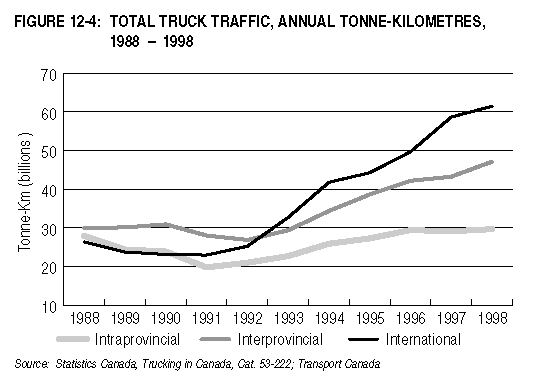
Table 12-2 shows the amount of for-hire truck traffic by sector
and province for 1998. Ontario accounted for the largest share
of truck traffic in both domestic and international markets, with
51.3 billion tonne-kilometres, or 37.1 per cent of the total tonne-kilometres.
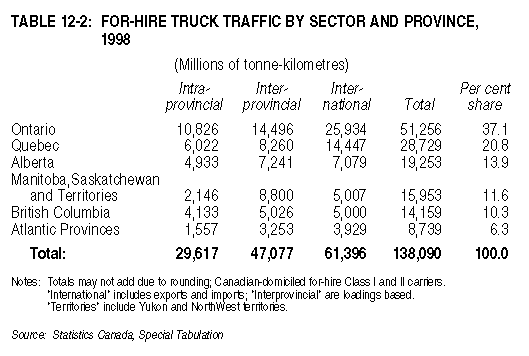
Table 12-3 shows the northbound and southbound flow of traffic
between US regions and Canadian provinces in 1998. Deliveries
to and from the US central states accounted for the largest share
of traffic with 22.1 billion tonne-kilometres, or 36.0 per cent
of the total tonne-kilometres.

Truck Traffic by Commodity
In terms of transportation revenues, general freight (primarily
manufactured products and fabricated materials) accounted for
a significant share of truck traffic in 1998. Domestic traffic
in this commodity group generated close to $2.7 billion in revenues,
or 41.5 per cent of all domestic revenues. International traffic
generated approximately $2.2 billion, or 46 per cent of all international
revenues. Based on domestic and international traffic combined,
the next most important commodities transported were food products,
with about $1.8 billion, or 16.2 per cent of the total, and
forest products, with $1.6 billion, or 14.3 per cent
of the total. Together, these three commodities accounted for
almost three quarters of the carriers' revenues in 1998.
Table 12-4 shows the revenues of for-hire trucking activity
by major commodity group for 1998.

In terms of traffic volume measured by tonne-kilometres, general
freight accounted for 26.4 billion tonne-kilometres domestically,
or 34.5 per cent of all domestic traffic, and 24.3 billion tonne-kilometres
to the US and Mexico, or 39.5 per cent of all international traffic.
Combined, this represented almost 37 per cent of total tonne-kilometres
in 1998.
In aggregate, general freight, food products and forest products
accounted for almost 75 per cent of carriers' total tonne-kilometres
in 1998. Table 12-5 shows the volume of for-hire trucking
traffic by major commodity group for 1998.

Two major sources were responsible for the growth in freight
traffic carried by trucks: the general freight sector, where domestic
activities not only surpassed transborder volumes in terms of
tonne-kilometres, but were also responsible for much of the growth
in freight traffic; and the food products sector, which enjoyed
significant growth in both domestic and transborder flows.
Figures 12-5 and 12-6 compare domestic and international for-hire
truck traffic for these two important commodity groups from 1990
to 1998.

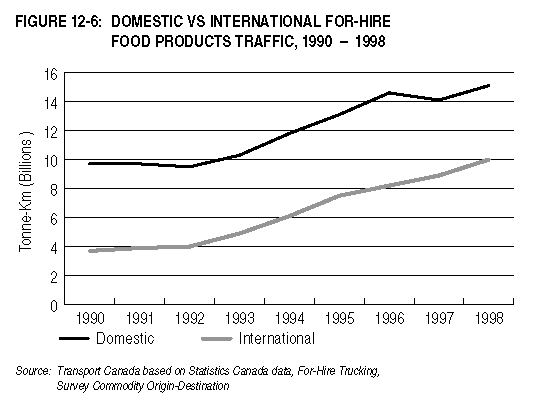
INTELLIGENT TRANSPORTATION SYSTEMS
APPLICATIONS AND THE CANADIAN TRUCKING INDUSTRY |
|
Given the increasing focus on Intelligent Transportation Systems
(ITS), Transport Canada launched a study to assess best practices
and state-of-the-art applications currently in use in the motor
carrier industry. A summary of the study, which was completed
in 1999, follows.
ITS can be defined as the application of advanced information
processing, communications, sensing and control technologies
to improve the way in which ground transportation systems
are designed, built, managed and operated.
These technologies are being considered by the motor carrier
industry as a way to enhance safety and efficiency of passenger
and freight transportation operations, and to promote competitiveness.
ITS applications have also been introduced to alleviate problems
associated with increased traffic congestion, instead of capital
expenditures to expand existing highway infrastructure.
Possible Barriers To Deployment of ITS Technologies
Despite carriers' awareness of the benefits of ITS technologies
to their operations, a number of impediments exist to broader
deployment of ITS.
- Cost of investment in technology -- Because rapid
technological changes make products quickly outdated, products
must be sold at prices high enough to cover developmental costs,
which deter many carriers from adopting them.
- Knowledge of ITS -- The lack of knowledge about ITS
also impedes investment, and Canada currently lacks the outreach
programs that might help increase awareness.
- Privacy issue -- Trucking companies are concerned
about the storage of private and confidential commercial information.
- Commercial issue -- Suppliers of ITS technology are
concerned about protecting their intellectual property rights,
as well as their market share.
- Resistance to change -- Workers often equate automation
with a potential loss of jobs, and therefore do not wish to change
the way they do business.
- Standardization -- The lack of standardization and
the proprietary nature of some of the technologies and products
have made it difficult, if not impossible, for the industry to
integrate their company's systems with the in-vehicle devices.
Similarly, operational policy and strategies are often developed
with little consultation, resulting in individual institutions
having similar but different requirements.
Current Uses of ITS Technology in Canada
There is a significant degree of adoption of ITS technology
in the Canadian trucking industry. It is, however, generally
limited to large companies operating a fleet of 100 trucks or
more. The driving force behind its use is competitiveness considerations,
particularly for carriers that have operations with a North American
scope. Furthermore, adopting ITS technology improves their productivity
and safety records, giving them a competitive edge in the market.
There are several types of ITS applications in use in the Canadian
trucking industry.
- Computerized information system -- A high percentage
of Canadian carriers use computerized management information
systems to manage their operations.
- On-board driver monitoring system -- This is an on-board
computer with a serial PC interface used to transfer data to
the fleet management computer to assess driver and vehicle performance.
- Satellite tracking -- This is an on-board vehicle
device that sends a periodic signal to the satellite. The communication
satellite then establishes the approximate location of the vehicle,
relaying this information to the dispatch office's tracking software.
- Global Positioning System (GPS) -- With a GPS, the
vehicle's on-board receiver triangulates its position based on
signals received from three or more GPS transmitting satellites.
The on-board computer then transmits the vehicle location to
the dispatcher by communication satellite or other means. The
GPS system is also being used to keep track of trailers. Functions
such as doors opening or temperature of cargo can also be monitored
in real time.
- Digital pager systems -- Text messages can be sent
directly to the driver using the satellite system or the cellular
network.
Opportunities for ITS in the Canadian Motor Carrier Industry
Implementing ITS technologies on a national scale requires
the full commitment of all levels of government and the trucking
industry, and close co-operation between the public and the private
sectors. Building on the experience and successes of the pilot
projects, ITS deployment has been expanding in North America
and can be enhanced to include additional features for future
ITS applications in the Canadian motor carrier industry.
- Roadside CVO stations -- The number of weigh stations
capable of electronic bypass could be increased. The number of
trucks to be equipped with transponders for toll payment, weigh
station bypass and customs clearance are expected to increase
significantly over the next few years.
- Commercial fleet management -- The use of on-board
computers could be extended to upload the driver routing slip,
customer list, billing information, etc. Technologies used for
vehicle tracking and communications could provide a basis for
implementing "Mayday" capabilities in emergency situations.
- Enroute driver information -- Transponders could interface
with other on-board devices for display functions to display
information to the driver, such as weather, traffic incidents,
road sign information, etc.
- On-board safety monitoring -- Safety systems could
monitor the safety status for the vehicle (brakes, lights, tires,
air pressure, speed, steering and electrical system), the
driver (hours of service, alertness) and cargo (unsafe conditions
relating to cargo carried in the vehicle).
- Commercial vehicle administrative processes -- The
carriers could electronically capture information on mileage,
fuel purchased, and trip and vehicle data by province (and state),
including licences, registrations, operating authority, leasing,
insurance, permits, mileage and fuel tax reporting, safety records,
audits and credentials.
- Route guidance -- In-vehicle navigation systems using
GPS will be an option for most trucks within a few years, providing
vehicle location, mapping, traveller route planning and route
guidance.
- Dangerous goods incident response -- Transponders
could enable the tracking of the movement of dangerous goods
and provide truck-specific cargo information to enhance the response
to dangerous goods incidents.
Conclusions
Commercial vehicle operators and their different agencies
have a common interest in deploying ITS applications. However,
a number of hurdles have to be overcome to achieve success. The
perceived barriers from the motor carrier industry perspective
can be addressed by the following types of action.
- Education -- Increase awareness of the associated
benefits of ITS technologies by promoting it through trucking
associations and ITS Canada, focused government information
campaigns (through vehicle registration and truck driver permit
renewals, at roadside inspection stations, border crossings,
etc.).
- Regulatory -- Set guidelines to protect privacy and
intellectual property.
- National ITS Architecture -- Develop a national ITS
architecture for integrating various commercial vehicle applications
compatible with the US architecture, but taking into consideration
the unique needs of Canada.
- Public/Private-Sector Participation -- Foster co-operation
and involvement of all sectors to better balance investments
and increase market stimulation.
- Harmonized Standards -- Develop North American standards
and achieve true inter-operability.
|
Truck Fleet
Class 8 heavy trucks include those vehicles with a gross vehicle
weight of 15,000 kilograms or more. There was a total of 262,226
Class 8 trucks registered across the country in 1999. To that
figure must be added an additional 386,804 "heavy vehicles,"
which include those vehicles used for picking up and delivering
goods and that weigh more than 10,000 kilograms. Three provinces,
Ontario, Quebec and Alberta, accounted for 74 per cent of all
Class 8 trucks registered in Canada in 1999, and 63 per cent
of all registered heavy vehicles.
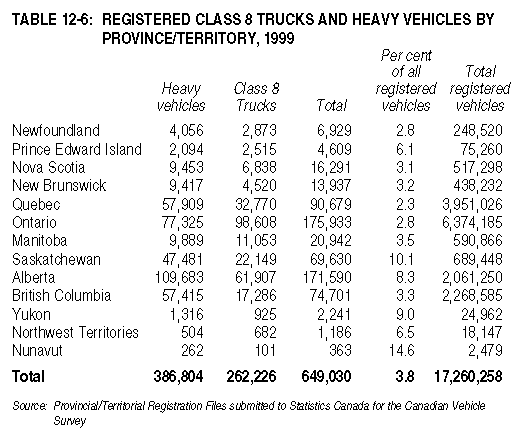
Truck Sales
In 1999, there were 30,984 new Class 8 trucks sold in Canada,
establishing a new record for sales of such vehicles. These new
truck purchases reflect a pent-up demand following the deferred
fleet replacement during the 1990-1992 recession, as well as strong
growth in the demand for truck freight services since 1993. Table
12-7 compares the sale of Class 8 trucks by province from 1997
to 1999.

Sales of Class 8 trucks were 6.5 per cent higher in 1999 than
in 1998. A number of factors, favourable to heavy truck sales,
that were present in 1998 -- strong manufacturing output, relatively
favourable interest rates, controlled inflation and increased
consumer spending -- were also present in 1999, all pointing to
a strong demand for truck freight transport.
When Canadian sales of Class 8 trucks in a given year are related
to the number of registered Class 8 trucks, it gives an idea of
the importance of the replacement rate of vehicles in the trucking
industry (Table 12-8). Replacement rates vary from one region
to another, a situation that would have to be analysed at a micro-level
to determine whether or not it is indicative of an appropriate
or inappropriate rate of replacement. In Canada as a whole, more
than 11 per cent of registered Class 8 trucks in operation during
1999 were new trucks.
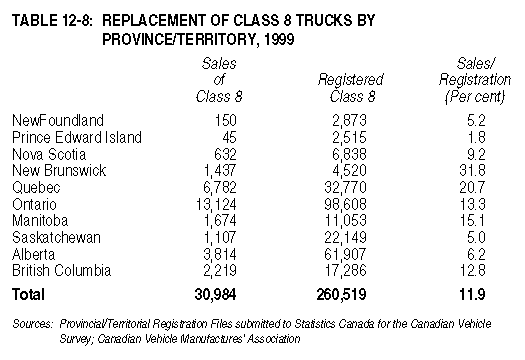
Figure 12-7 shows the annual sale of Class 8 trucks in Canada
between 1990 and 1999.

Trucking Transportation
|

